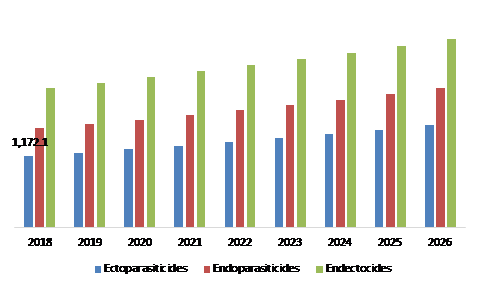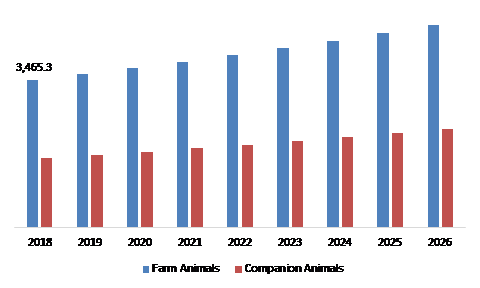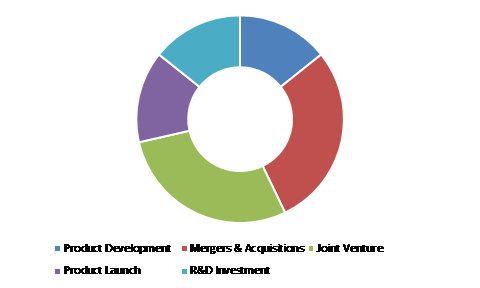Animal Parasiticides Market Report
RA00056
Animal Parasiticides Market, by Product Types (Ectoparasiticides [Pour On, Spot On, Sprays], Endoparasiticides [Injectable, Oral], Endectocides), Animal Type (Farm Animals, Companion Animals), Regional Analysis (North America, Europe, Asia-Pacific, LAMEA): Global Opportunity Analysis and Industry Forecast, 2019–2026
Update Available On-Demand
Global Animal Parasiticides Market Overview 2026
According to the animal parasiticides market analysis by Research Dive, the market will surpass $ 7,082.2 Million by 2026, increasing from $ 5,096.0 Million in 2018, at a CAGR of 4.2%. Asia-Pacific market is expected to drive $ 1,614.8 Million by 2026 at a highest growth rate of 4.7% till 2026. North American market dominated the global market, accounting for a major share of 37.0% in 2018.
Animal parasiticides or antiparasitics are the chemical materials which are used to eradicate or kill the animal health-affecting parasites. These parasiticides target the infectious parasites by destroying them or inhibiting their growth. The major types of animal parasiticides are ectoparasiticides and endoparasiticides.
Market Drivers:
Rising demand for pet animals is one of the key factor driving the animal parasiticide market
The key animal parasiticide market drivers include the rise in demand for pet animals and animal protein food across the globe. As these parasiticides are capable of enhancing the health of pet animals, they are preferred significantly. Moreover, the growth is attributed to the increase in the occurrence of parasite infections and diseases among the livestock, pet animals and other animals, which in turn is enhancing the demand for animal parasiticides during the forecast period. Furthermore, rising awareness about the health of pet animals and livestock will further increase the adoption of animal parasiticides. Significant rise in demand for animal food protein products are further expected to enhance the product sales.
Market Restraints:
High cost of parasiticides, coupled with high R&D investments are restraining the animal parasiticide market growth
The market is restrained by the high product costs of parasiticides. Moreover, the R&D facilities for animal parasiticides require huge investments, in order to develop new and effective products to improve the animals’ health. Lack of proper funding for R&D facilities will significantly restrain the growth of animal parasiticide market.
Investment Opportunities in Animal Parasiticides Market
Governmental initiatives towards the safety of animals’ health will provide significant investment opportunities for the growth of animal parasiticide market
The governing bodies of both developed and developing regions are taking several measures in order to enhance the animals’ health. Moreover, the key players are taking steps to decrease the price of parasiticides. This might significantly enhance the product’s consumption among the customers.
Animal Parasiticide Market, by Product Type
Ectoparasiticides product type is predicted to be most lucrative till the end of 2026

Source: Research Dive Analysis
The ectoparasiticides market is expected to experience the significant growth over forecast period due to the increasing need for treatment of infestations among the animals. The ectoparasiticides market is expected to account for $ 1,678.5 Million by 2026, increasing from $ 1,172.1 Million in 2018.
The endoparasiticides market has accounted for second highest market size in 2018, and is projected to reach $ 2,294.6 Million by 2026. This growth is attributed to the rise in product use for controlling roundworms, fluke and tapeworms in the animals’ body.
Animal Parasiticide Market, by Animal Type
Companion animal type segment is predicted to be most lucrative till the end of 2026

Source: Research Dive Analysis
Companion animal segment will witness a significant growth during the forecast period, due to increase in the pet animal’s adoption rate across the globe. Additionally, increase in the expenditure on animal health to protect from zoonotic diseases is projected to drive the market growth in the coming years. The revenue generated by the sale of animal parasiticides for companion animals is projected to account for $ 2,323.0 Million by 2026.
Animal Parasiticide Market, by Region:
Asia-Pacific region will have enormous opportunities for the market investors to grow over the coming years
Asia-Pacific Animal Parasiticide Market Overview 2026:
Asia-Pacific market of animal parasiticide is anticipated to experience significant growth and generated $ 1,121.1 Million in 2018. The growth is attributed to the existence of huge number of farm animals and increase in the demands for quality meat is directly impacting the parasiticides market, due to this, Asia-Pacific animal parasiticide is expected to drive the market over the forecast period accounting for $ 1,614.8 Million by 2026 at a highest growth rate of 4.7% till 2026.
North America Animal Parasiticide Market Outlook 2026:
North American market dominated the global market, accounting for a major share of 37.0% in 2018. The dominance is due to the rise in adoption of pet animals and well established healthcare centers for animals in countries such as Canada, and the U.S.
Key participants in Global Animal Parasiticide Market:
Product development and joint ventures are the most common strategies followed by the market players

Source: Research Dive Analysis
The animal parasiticide market players include Sanofi, Zoetis Inc., Eli Lilly, Elanco, Ceva Santé Animale, Perrigo Company Plc, Boehringer Ingelheim animal Health, Merck Co., Vetoquinol, and Bayer AG. Top key players are adopting new strategies such as joint ventures, mergers & acquisitions, new product developments and geographical expansions to increase their company position in the global market. For instance, in November 2019, Bayer AG collaborated with Pharmaron as its global partner for “Chemistry, Manufacturing and Controls (CMC) services of small molecule”. This includes drug product and drug substance manufacturing to support Bayer AG research.
Scope of the Market Report:
| Aspect | Particulars |
| Historical Market Estimations | 2018-2019 |
| Base Year for Market Estimation | 2018 |
| Forecast timeline for Market Projection | 2019-2026 |
| Geographical Scope | North America, Europe, Asia-Pacific, LAMEA |
| Segmentation by Product Type
|
|
| Segmentation by Animal Type
|
|
| Key Countries covered | U.S., Canada, Germany, UK, Italy, Spain, Russia, Japan, China, India, South Korea, Australia, Brazil, Argentina, GCC, and Saudi Arabia |
| Key Companies Profiled |
|
Source: Research Dive Analysis
Q1. What is the size of the Animal Parasiticide Market?
A. The global Animal Parasiticide Market size was over $ 5,096.0 Million in 2018, and is further anticipated to reach $ 7,082.2 Million by 2026.
Q2. Who are the leading companies in the Animal Parasiticide Market?
A. Zoetis Inc., Sanofi, Bayer AG, and Perrigo Company Plc, some of the key players in the global Animal Parasiticide Market.
Q3. Which region possesses greater investment opportunities in the coming future?
A. Asia-Pacific possesses great investment opportunities for investors to witness the most promising growth in the coming years.
Q4. What is the growth rate of the Asia-Pacific Market?
A. Asia-Pacific Animal Parasiticide Market is projected to grow at 4.7% CAGR during the forecast period.
Q5. What are the strategies opted by the leading players in this market?
A. Product development and joint ventures are the key strategies opted by the operating companies in this market.
Q6. Which companies are investing more on R&D practices?
A. Bayer AG, Sanofi and Zoetis Inc., are investing more on R&D activities for developing new products and technologies.
1. Research Methodology
1.1. Desk Research
1.2. Real time insights and validation
1.3. Forecast model
1.4. Assumptions and forecast parameters
1.4.1. Assumptions
1.4.2. Forecast parameters
1.5. Data sources
1.5.1. Primary
1.5.2. Secondary
2. Executive Summary
2.1. 360° summary
2.2. Product Type trends
2.3. Animal Type trends
3. Market overview
3.1. Market segmentation & definitions
3.2. Key takeaways
3.2.1. Top investment pockets
3.2.2. Top winning strategies
3.3. Porter’s five forces analysis
3.3.1. Bargaining power of consumers
3.3.2. Bargaining power of suppliers
3.3.3. Threat of new entrants
3.3.4. Threat of substitutes
3.3.5. Competitive rivalry in the market
3.4. Market dynamics
3.4.1. Drivers
3.4.2. Restraints
3.4.3. Opportunities
3.5. Technology landscape
3.6. Regulatory landscape
3.7. Patent landscape
3.8. Pricing overview
3.8.1. By product type
3.8.2. By animal type
3.8.3. By region
3.9. Market value chain analysis
3.9.1. Stress point analysis
3.9.2. Raw material analysis
3.9.3. Manufacturing process
3.9.4. Distribution channel analysis
3.9.5. Operating vendors
3.9.5.1. Raw material suppliers
3.9.5.2. Product manufacturers
3.9.5.3. Product distributors
3.10. Strategic overview
4. Animal Parasiticide Market, by Product Type
4.1. Ectoparasiticides
4.1.1. Market size and forecast, by region, 2018-2026
4.1.2. Comparative market share analysis, 2018 & 2026
4.1.3. Pour On
4.1.3.1. Market size and forecast, by region, 2018-2026
4.1.3.2. Comparative market share analysis, 2018 & 2026
4.1.4. Spot On
4.1.4.1. Market size and forecast, by region, 2018-2026
4.1.4.2. Comparative market share analysis, 2018 & 2026
4.1.5. Sprays
4.1.5.1. Market size and forecast, by region, 2018-2026
4.1.5.2. Comparative market share analysis, 2018 & 2026
4.2. Endoparasiticides
4.2.1. Market size and forecast, by region, 2018-2026
4.2.2. Comparative market share analysis, 2018 & 2026
4.2.3. Injectables
4.2.3.1. Market size and forecast, by region, 2018-2026
4.2.3.2. Comparative market share analysis, 2018 & 2026
4.2.4. Oral
4.2.4.1. Market size and forecast, by region, 2018-2026
4.2.4.2. Comparative market share analysis, 2018 & 2026
4.2.4.3. Liquids
4.2.4.3.1. Market size and forecast, by region, 2018-2026
4.2.4.3.2. Comparative market share analysis, 2018 & 2026
4.2.4.4. Tablets
4.2.4.4.1. Market size and forecast, by region, 2018-2026
4.2.4.4.2. Comparative market share analysis, 2018 & 2026
4.3. Endectocides
4.3.1.1. Market size and forecast, by region, 2018-2026
4.3.1.2. Comparative market share analysis, 2018 & 2026
4.4. Others
4.4.1. Market size and forecast, by region, 2018-2026
4.4.2. Comparative market share analysis, 2018 & 2026
5. Animal Parasiticide s Market, by Animal Type
5.1. Farm animals
5.1.1. Market size and forecast, by region, 2018-2026
5.1.2. Comparative market share analysis, 2018 & 2026
5.2. Companion animals
5.2.1. Market size and forecast, by region, 2018-2026
5.2.2. Comparative market share analysis, 2018 & 2026
6. Animal Parasiticide s Market, by Region
6.1. North America
6.1.1. Market size and forecast, by product type, 2018-2026
6.1.2. Market size and forecast, by animal type, 2018-2026
6.1.3. Market size and forecast, by country, 2018-2026
6.1.4. Comparative market share analysis, 2018 & 2026
6.1.5. U.S.
6.1.5.1. Market size and forecast, by product type, 2018-2026
6.1.5.2. Market size and forecast, by animal type, 2018-2026
6.1.5.3. Comparative market share analysis, 2018 & 2026
6.1.6. Canada
6.1.6.1. Market size and forecast, by product type, 2018-2026
6.1.6.2. Market size and forecast, by animal type, 2018-2026
6.1.6.3. Comparative market share analysis, 2018 & 2026
6.2. Europe
6.2.1. Market size and forecast, by product type, 2018-2026
6.2.2. Market size and forecast, by animal type, 2018-2026
6.2.3. Market size and forecast, by country, 2018-2026
6.2.4. Comparative market share analysis, 2018 & 2026
6.2.5. Germany
6.2.5.1. Market size and forecast, by product type, 2018-2026
6.2.5.2. Market size and forecast, by animal type, 2018-2026
6.2.5.3. Comparative market share analysis, 2018 & 2026
6.2.6. UK
6.2.6.1. Market size and forecast, by product type, 2018-2026
6.2.6.2. Market size and forecast, by animal type, 2018-2026
6.2.6.3. Comparative market share analysis, 2018 & 2026
6.2.7. France
6.2.7.1. Market size and forecast, by product type, 2018-2026
6.2.7.2. Market size and forecast, by animal type, 2018-2026
6.2.7.3. Comparative market share analysis, 2018 & 2026
6.2.8. Spain
6.2.8.1. Market size and forecast, by product type, 2018-2026
6.2.8.2. Market size and forecast, by animal type, 2018-2026
6.2.8.3. Comparative market share analysis, 2018 & 2026
6.2.9. Italy
6.2.9.1. Market size and forecast, by product type, 2018-2026
6.2.9.2. Market size and forecast, by animal type, 2018-2026
6.2.9.3. Comparative market share analysis, 2018 & 2026
6.2.10. Rest of Europe
6.2.10.1. Market size and forecast, by product type, 2018-2026
6.2.10.2. Market size and forecast, by animal type, 2018-2026
6.2.10.3. Comparative market share analysis, 2018 & 2026
6.3. Asia Pacific
6.3.1. Market size and forecast, by product type, 2018-2026
6.3.2. Market size and forecast, by animal type, 2018-2026
6.3.3. Market size and forecast, by country, 2018-2026
6.3.4. Comparative market share analysis, 2018 & 2026
6.3.5. China
6.3.5.1. Market size and forecast, by product type, 2018-2026
6.3.5.2. Market size and forecast, by animal type, 2018-2026
6.3.5.3. Comparative market share analysis, 2018 & 2026
6.3.6. India
6.3.6.1. Market size and forecast, by product type, 2018-2026
6.3.6.2. Market size and forecast, by animal type, 2018-2026
6.3.6.3. Comparative market share analysis, 2018 & 2026
6.3.7. Australia
6.3.7.1. Market size and forecast, by product type, 2018-2026
6.3.7.2. Market size and forecast, by animal type, 2018-2026
6.3.7.3. Comparative market share analysis, 2018 & 2026
6.3.8. Rest of Asia Pacific
6.3.8.1. Market size and forecast, by product type, 2018-2026
6.3.8.2. Market size and forecast, by animal type, 2018-2026
6.3.8.3. Comparative market share analysis, 2018 & 2026
6.4. LAMEA
6.4.1. Market size and forecast, by product type, 2018-2026
6.4.2. Market size and forecast, by animal type, 2018-2026
6.4.3. Market size and forecast, by country, 2018-2026
6.4.4. Comparative market share analysis, 2018 & 2026
6.4.5. Latin America
6.4.5.1. Market size and forecast, by product type, 2018-2026
6.4.5.2. Market size and forecast, by animal type, 2018-2026
6.4.5.3. Comparative market share analysis, 2018 & 2026
6.4.6. Middle East
6.4.6.1. Market size and forecast, by product type, 2018-2026
6.4.6.2. Market size and forecast, by animal type, 2018-2026
6.4.6.3. Comparative market share analysis, 2018 & 2026
6.4.7. Africa
6.4.7.1. Market size and forecast, by product type, 2018-2026
6.4.7.2. Market size and forecast, by animal type, 2018-2026
6.4.7.3. Comparative market share analysis, 2018 & 2026
7. Company profiles
7.1. Sanofi
7.1.1. Business overview
7.1.2. Financial performance
7.1.3. Product portfolio
7.1.4. Recent strategic moves & developments
7.1.5. SWOT analysis
7.2. Zoetis Inc.
7.2.1. Business overview
7.2.2. Financial performance
7.2.3. Product portfolio
7.2.4. Recent strategic moves & developments
7.2.5. SWOT analysis
7.3. Eli Lilly
7.3.1. Business overview
7.3.2. Financial performance
7.3.3. Product portfolio
7.3.4. Recent strategic moves & developments
7.3.5. SWOT analysis
7.4. Elanco
7.4.1. Business overview
7.4.2. Financial performance
7.4.3. Product portfolio
7.4.4. Recent strategic moves & developments
7.4.5. SWOT analysis
7.5. Ceva Santé Animale
7.5.1. Business overview
7.5.2. Financial performance
7.5.3. Product portfolio
7.5.4. Recent strategic moves & developments
7.5.5. SWOT analysis
7.6. Perrigo Company Plc
7.6.1. Business overview
7.6.2. Financial performance
7.6.3. Product portfolio
7.6.4. Recent strategic moves & developments
7.6.5. SWOT analysis
7.7. Boehringer Ingelheim animal Health
7.7.1. Business overview
7.7.2. Financial performance
7.7.3. Product portfolio
7.7.4. Recent strategic moves & developments
7.7.5. SWOT analysis
7.8. Merck Co.
7.8.1. Business overview
7.8.2. Financial performance
7.8.3. Product portfolio
7.8.4. Recent strategic moves & developments
7.8.5. SWOT analysis
7.9. Vetoquinol
7.9.1. Business overview
7.9.2. Financial performance
7.9.3. Product portfolio
7.9.4. Recent strategic moves & developments
7.9.5. SWOT analysis
7.10. Bayer AG
7.10.1. Business overview
7.10.2. Financial performance
7.10.3. Product portfolio
7.10.4. Recent strategic moves & developments
7.10.5. SWOT analysis
The chemical materials which are used to eliminate or kill the animal health-affecting parasites are called animal parasiticides or antiparasitics. These parasiticides target the infectious parasites by destroying them or inhibiting their growth.
Parasites are organisms that survive by attacking pets and farm animals for nourishment. They live in or on the body, benefiting from food and protection, while the unfortunate host animal suffers. External parasites, such as ticks, can then transfer disease from animals to people. However, a combination of watchful management of animals and targeted medicines can control parasites before these organisms cause serious harm.
The Factors Propelling the Growth of the Market
Rising demand for pet animals is one of the key factors driving the animal parasiticide market . The key animal parasiticide market drivers include the rise in demand for pet animals and animal protein food across the globe. As these parasiticides are capable of enhancing the health of pet animals, they are preferred significantly. Moreover, the growth is attributed to the increase in the occurrence of parasite infections and diseases among the livestock, pet animals and other animals, which in turn is enhancing the demand for animal parasiticides during the forecast period. Furthermore, rising awareness about the health of pet animals and livestock will further increase the adoption of animal parasiticides. Significant rise in demand for animal food protein products are further expected to enhance the product sales.
Recent Developments
The animal parasiticide market players which are making a difference are Sanofi, Zoetis Inc., Eli Lilly, Elanco, Ceva Santé Animale, Perrigo Company Plc, Boehringer Ingelheim animal Health, Merck Co., Vetoquinol, and Bayer AG. Top key players are adopting new strategies such as joint ventures, mergers & acquisitions, new product developments and geographical expansions to increase their company position in the global market.
- In November 2019, Bayer AG collaborated with Pharmaron as its global partner for “Chemistry, Manufacturing and Controls (CMC) services of small molecule”. This includes drug product and drug substance manufacturing to support Bayer AG research.
- Zoetis, a leading company has got approval of the US Food and Drug Administration for its new product, Simparica TrioTM (sarolaner, moxidectin, and pyrantel chewable tablets). It is a new combination parasite preventative for dogs. It is also the first one-monthly, chewable tablet in the US that delivers all-in-one protection from heartworm disease, ticks and fleas, roundworms and hookworms. This combination product builds on the trusted legacy of Simparica® (sarolaner) Chewables and exemplifies Zoetis’ dedication to innovation in parasiticides.
- Elanco Animal Health Inc. clinched the purchase of Bayer AG’s animal-health unit in a deal valued at $7.6 billion, creating one of the biggest stand-alone veterinary-medicine companies in the world. Elanco, which was spun out from drugmaker Eli Lilly & Co. last year, will finance the acquisition with a mix of cash and stock. German drug giant Bayer AG will receive $5.32 billion in cash and $2.3 billion in Elanco Animal Health common shares. The transaction is expected to close in mid-2020. (Source: https://www.bloomberg.com/)
Personalize this research
- Triangulate with your own data
- Request your format and definition
- Get a deeper dive on a specific application, geography, customer or competitor
- + 1-888-961-4454 Toll - Free
- support@researchdive.com

